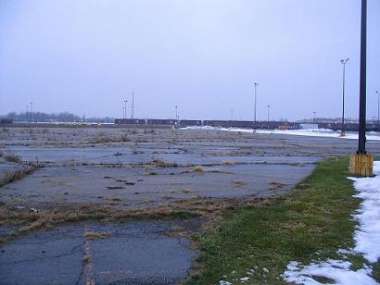Introduction
Jan. 5, 2016: This story has been corrected.
In December 1997, a company called Select Steel moved to enter the then-bustling economy of Flint, Michigan.
It applied for an air permit with the Michigan Department of Environmental Quality, seeking to build a “mini-mill” abutting the city’s northern edge that would melt and recast scrap metal. The mill would send up to 100 tons of lead per year, as well as particulate matter, nitrogen oxide and other pollutants into the atmosphere.
Residents of the area already were dealing with pollution from the wood-burning Genesee Power Station. Nonetheless, in May 1998, state regulators approved Select Steel’s permit.
“This was just more unethical pouring of stuff into the North End,” said Father Philip Schmitter, pastor at Christ the King Catholic Church in Flint.
As it turned out, the Select Steel mill was never built. But the threat of its existence prompted angry residents to file a complaint against the state with the U.S. Environmental Protection Agency’s Office of Civil Rights. The case led to the office’s first formal decision and set it on a course that many believe is misguided.
Because of Select Steel, the office to this day relies heavily on science — too heavily, critics say — to investigate alleged violations of Title VI of the Civil Rights Act of 1964, which prohibits racial discrimination by recipients of federal funding such as states and cities.
The prospect of a new pollution source is not enough to show a discriminatory impact on a community, the EPA has decided. Instead, it parses data to see whether emission levels will rise above legal limits set by the agency to prevent harm to the environment and human health.
The Select Steel case “casts a shadow on civil-rights enforcement,” said Marianne Engelman Lado, of the public-interest law firm Earthjustice. “It raises significant questions about EPA’s backbone and willingness to enforce the civil-rights statute.”
In a statement to the Center for Public Integrity, EPA officials defended their approach.
“In accordance with case law and [Department of Justice] guidance, all federal agencies, including the EPA, must determine whether there is sufficient harm for a disparate impact complaint to be actionable,” the statement said.
A Center investigation in August found that the Office of Civil Rights has routinely failed to enforce Title VI. The office has dismissed nine out of every 10 community claims alleging environmental discrimination, the Center found, and has never once issued a formal finding of a Title VI violation.
EPA officials say they have begun the work of turning the office around. They have announced plans to do more frequent compliance reviews and publish an annual report to chart the office’s progress. This month they issued a notice of proposed rulemaking removing certain deadlines and put out a case manual for investigators examining civil-rights claims.

Boom and bust
An hour northeast of Detroit, Flint was built on the back of General Motors. The automaker’s 400-acre complex, dubbed “Buick City,” which paralleled the Flint River and employed more than 27,000 workers, dominated the city’s landscape for much of the 20th century. For many in Flint, the path to the middle class went through the assembly lines.
By 2014, 15 years after the automotive industry fled, 41 percent of Flint’s 99,002 residents lived in poverty; the median household income was $24,679. Rising crime has pegged Flint among today’s most dangerous American cities.
Schmitter has seen the city boom and bust. For years, he was co-director at the St. Francis Prayer Center, a Catholic retreat on the north side of Flint, but he also lived in the community. He was well acquainted with the challenges some poorer residents had to face.
A social-justice stalwart, Schmitter sensed trouble when, in 1992, the Genesee Power Station sought a home in Genesee Township, just beyond the Flint city limits.
“That’s a favored tactic of big business,” Schmitter said. “They go to a city, but put the facility in the neighboring township.”
He and his late colleague, Sister Joanne Chiaverini, filed a civil-rights complaint with the EPA, protesting the facility’s permit. They filed another complaint in 1994, but the power plant went into operation the following year, as they waited for a response.
In June 1998 the church filed another complaint, this time asking the EPA to intervene in the proposed Select Steel project. It claimed state regulators had “sped through” the permitting process to avoid a court order requiring them to provide “meaningful” citizen participation and conduct an environmental review for each new polluting facility.
“The same unfair and disparate burden of pollution will fall on a group of minority, low income people, as in the case already before the EPA,” Schmitter and Chiaverini wrote, referring to the Genesee complaint. “We await your prompt and decisive action!”
Embracing science
More than 500 miles from Flint, in Washington, D.C., things were heating up for civil-rights investigators and administrators at the EPA.
In the late 1990s, civil-rights cases were still a novelty at the agency. By the time Select Steel came across investigators’ desks, the EPA had only received 50 complaints.
“There was no case law, there was no policy. There was no environmental framework for doing the analysis,” then-director Ann Goode said in a recent interview with the Center, “so all of this was fresh ground.”
The U.S. Commission on Civil Rights had called for the EPA to develop guidelines for handling allegations of discrimination cases, while Congress pushed for a more scientifically rigorous approach by the agency overall. The civil-rights office tapped the EPA’s Science Advisory Board to analyze two proposed methods of assessing Title VI complaints.
The board dismissed as “insufficient” a method that considered the environmental harm caused by industrial facilities in a given area, comparing exposures in minority communities to those in white communities. Another method took into account the pollution burden from stationary, mobile and other sources in an area and compared it to legal limits. That method showed promise, the board said.
In Flint, then-EPA analyst Loren Hall was putting a version of this concept into practice. A monitor in a city park kept track of air pollution from the factories that loomed over neighborhoods. Hall looked for data suggesting Select Steel would have an “adverse disparate impact.”
He found none, he said; the levels of pollutants released by existing facilities were “way below” the legal threshold. As a result, his analysis of the project would hinge on the levels projected in the Select Steel permit. Those, too, did not give the agency the ammunition it needed to issue a finding of discrimination.
On October 30, 1998, after working around the clock to meet a promised deadline, the EPA found that the permit did not violate the civil rights of African-American residents. The mill clearly would discharge mercury and other pollutants, the agency found, but because emission levels would not exceed environmental standards, there was no adverse disparate impact.
“Health-based standards have nothing to do with civil rights,” said Engelman Lado, of Earthjustice. “The act of spewing the mercury is a disproportionate effect — that’s bad enough. It doesn’t have to be peer-reviewed bad. It just has to be a bad effect.”
In the end, community opposition proved too much for the steel company. Plans for the Flint mill were scrapped, and Select Steel eyed a new location near Lansing.
Plans for that facility also were abandoned after the company failed to get financing.
Debate over ‘adversity standard’
The Select Steel case remains a touchstone, sparking a debate over the EPA’s adversity standard that rages still.
Under Title VI, advocates argue, the mere act of releasing a toxic substance like mercury should constitute disproportionate harm. Instead, they say, the agency substitutes environmental law for civil-rights law.
“We’re still at an impasse,” Engelman Lado said. “This fight over the adversity standard is one of the key barriers for them enforcing civil rights.”
Goode said she empathizes.
“It’s understandable from the community’s perspective; they haven’t gotten a win,” she said. “I wouldn’t be satisfied if I were sitting on that side. No way.”
Still, Goode defended EPA’s reliance on science-based analysis, saying it lends legitimacy to the agency’s decisions.
“There has to be some logic to this,” she said. “I don’t think you could issue an opinion otherwise.”
Hall also stands by the Select Steel analysis.
“It’s not that the environmental justice concerns aren’t credible,” he said. “But at [the Office of Civil Rights] we have to prove adverse disparate impacts by a preponderance of the evidence.”
Adapting civil-rights law for the environmental context has proven tricky, said Joseph Rich of the Lawyers’ Committee for Civil Rights Under Law. Most cases dealing with disparate impacts involve housing or employment issues, he said, leaving the EPA to do the best it can with the case law that’s out there.
“They’re all looking at the same basic standard, but how you apply it … is a difficult issue,” said Rich, who co-directs the committee’s fair housing program.
The EPA for years has grappled with how to evaluate civil-rights cases.
In 2000, it drafted policy guidelines that allowed targets of civil-rights complaints to argue there was no discrimination if a facility complied with environmental standards. The agency issued a position paper in 2013 promising to eliminate that defense under pressure from advocates. In its statement to the Center, the EPA said it is “still considering and working on this issue.”
While the EPA sorts things out, Schmitter and others in Flint are still waiting to see what will come of the Genesee Power Plant case, pending since 1994. Earthjustice filed a lawsuit against the EPA on behalf of five community groups, including the St. Francis Prayer Center, with civil-rights cases that have been pending for at least a decade.
“I’m not happy with the distinction of filing the oldest unacted-upon case in the history of EPA,” Schmitter said. “That’s not a battle ribbon I want to be wearing.”
Jan. 5, 2016: An earlier version of this story misstated the name of the Lawyers’ Committee for Civil Rights Under Law.
Read more in Environment
Environment
‘It just ruined everything — the whole life’
Feeling abandoned by state regulators, hundreds of rural Pennsylvanians endure contaminated well water they blame on fracking
Environment
Hot mess: states struggle to deal with radioactive fracking waste
Potentially dangerous drilling byproducts are being dumped in landfills throughout the Marcellus Shale with few controls



Join the conversation
Show Comments